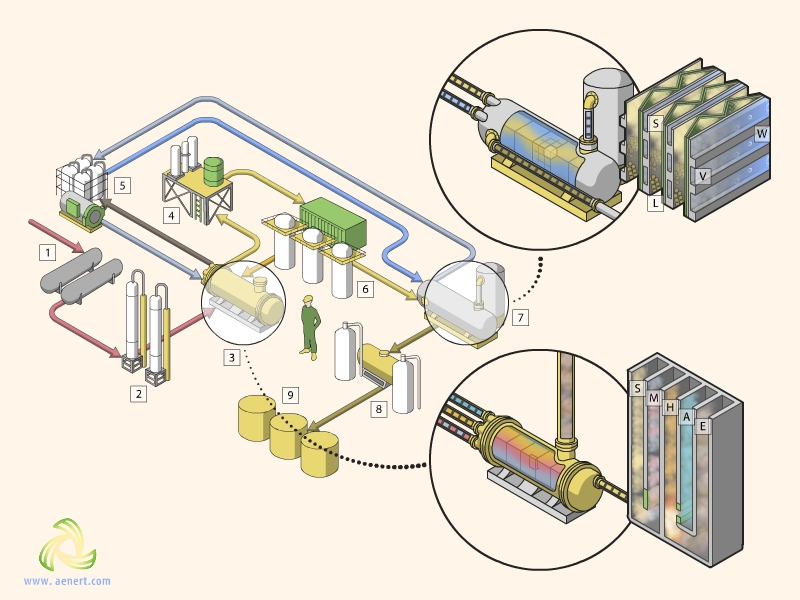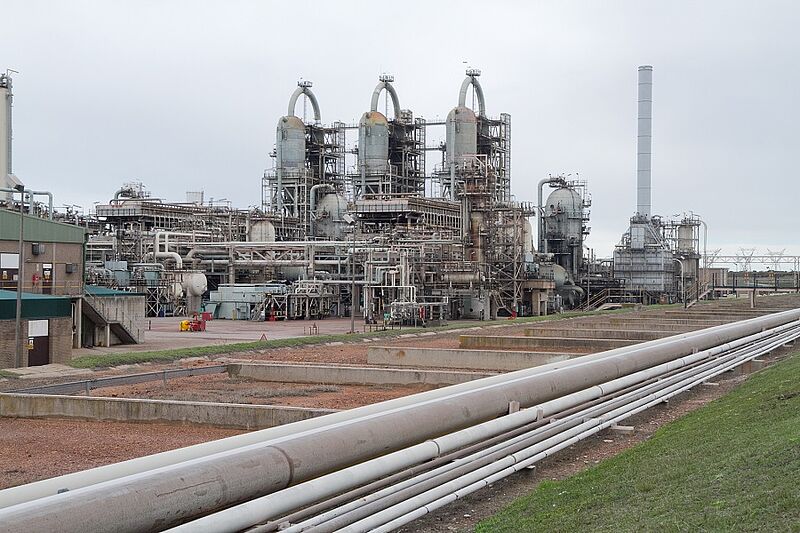Gas to Liquid (GTL) technologies have several stages of long and relatively successful development, as well as a fairly developed infrastructure for their application. On the one hand, the now long history of operation of large GTL plants in Qatar, South Africa, Malaysia and Nigeria demonstrate the attractiveness of this technology, but on the other hand, high capital costs and troublesome dependence on the changing conditions of the free market hinder its large-scale development.
Initially, the technology for converting one type of fossil fuel to another was developed in Germany almost a hundred years ago, it made it possible to obtain liquid fuel from coal (Coal to liquid – CTL). The technology was named after the names of its authors – Fischer-Tropsch process. It is based on a two-stage process – production of synthesis gas, i.e., hydrogen and carbon monoxide, and its subsequent conversion into various long-chain molecule hydrocarbons. In the fifties of the last century, these results were adapted and supplemented in South Africa, where CTL and a little later – GTL technologies achieved a real industrial scale. In both cases the real reason for developing this process was the shortage of liquid fuel and unavailability of oil resources. Among other reasons for the implementation of GTL and CTL in various countries was the great prevalence of one type of feedstock over others, unwillingness to depend on expensive imports of certain types of fossil fuels, and attempts to occupy the main market niches of hydrocarbon products. Previously, the environmental benefits of synthetic fuels were also often mentioned, however, since Fischer-Tropsch synthesis involves high-temperature process with a noticeable carbon footprint from the feedstock used and are accompanied by carbon dioxide emissions, this indicator has become much less mentioned recently. Among the large-scale GTL projects implemented in recent years, plants in Turkmenistan and Uzbekistan should be mentioned. However, at the same time, several projects were discontinued. According to U.S. Energy Information Administration, International Energy Outlook 2017, in the next two decades, one should not expect the introduction of new large-scale GTL projects in the world, except for their possible construction in South Africa, which is still only an intention. Thus, the prospects for the development of large-scale GTL seem unconvincing.

However, in the last decade, new horizons for the development of GTL technologies have been proposed by the developers of small-scale, mini- and micro-GTL, hereinafter simply small-scale GTL. Unlike traditional large-scale GTLs, which operate with volumes over 100 MMscfd, the capacities of small-scale GTL range between 0.1–10 MMscfd. The new technologies have a number of significant benefits. In particular, lower requirements for natural gas reserves, lower capital costs, and reduced construction time. Considering that small-scale GTL plants can be modular and use associated petroleum gas as feedstock, the prospects for their scaling seemed limitless. In addition, the use of microchannel structures in small-scale GTL plants can substantially intensify Fischer-Tropsch chemical processes by increasing the efficiency of heat transfer and catalyst activity.
Simplified GTL microchannel technology

1. Gas treatment; 2. Desulfurization; 3. SMR microchannel reactor; 4. Compressor station; 5. Boiler & Cooling Water Unit; 6. Hydrogen membranes; 7. F-T microchannel reactor; 8. Product separation unit; 9. Stock of liquid hydrocarbons; S – Syngas(H2+CO); L – Liquid hydrocarbons; V – Vapor; W – Water cooling; M – Methane+Steam; H – Hydrogen; A – Air; E - Exhaust
The main idea of implementing small-scale GTL plants was to realize the capabilities of using associated gas in remote oil fields, devoid of traditional gas transportation infrastructure. In this case, small-scale GTL plants make it possible to obtain synthetic oil or even valuable products, including diesel fuel, which could be used on site for process needs, pumped into oil pipelines (in the case of synthetic oil), or sent to the consumer, for example, by road. Given that the world annually flares several billion cubic meters of associated petroleum gas (144 billion m3 in 2021) in almost all oil-producing countries, there is no concern about the resource base for small-scale GTL plants. In addition, landfill gas, coal bed methane, various refinery gas mixtures, and biomass-derived syngas (BTL) can be used as feedstock for these technologies. A detailed list of proposed equipment, technological parameters of processes, feedstock requirements, as well as a description of demonstration and commercial projects are well presented in the Technology Overview - Utilization of Small-Scale Associated Gas prepared by the Global Gas Flaring Reduction Partnership (GGFR). Among the main participants in this area, the following should be mentioned: CompactGTL, Calvert Energy Group, Velocys, Emerging Fuels Technology, GasTechno Energy & Fuels, Greyrock, MET Gas Processing Technologies S.p.A., Primus Green Energy, INFRA Technology Group, BgtL, and Rocky Mountain GTL Inc.
However, today we can state that this direction also was not properly developed. Despite the significant interest in small-scale GTL, now there are only a few commercially successful projects in the world. There are frequent delays in project implementation, technological failures and even bankruptcies. A multiple drop in the value of the shares of one of the leading developers of small-scale GTL technologies, Velocys, after peaking in 2014 can be a clear reflection of this. As a result, small-scale GTL technologies have not had a significant impact on reducing the volume of associated gas flaring or its re-injection into oil reservoirs in the last decade.
PetroSA, GTL Refinery, Mossel Bay, South Africa. Credit Creamer Media
There are several reasons for this, primarily of an economic and technological nature. Firstly, it is obvious that the products of small-scale GTL plants turned out to be simply uncompetitive in price and therefore were not demanded in the market. This is due to the high cost of production, the imperfection of technology, the lack of long experience in operating the equipment, but also to a general bad luck related to external circumstances. Since the economic performance of small-scale GTL ultimately highly depends on the ratio of market prices of natural gas and oil, it is their exorbitant volatility in recent years that has become one of the main reasons for commercialization failures. Indeed, the precipitous fall in oil prices in 2014-2016, the negative values of oil futures contracts in March 2020, the multiple increase in the cost of natural gas starting from the second half of 2021 could not but adversely affect the development of small-scale GTL. This situation was further exacerbated by the rapid development of renewable energy, COVID-19 restrictions, and a decrease in investment in oil and gas production. The linking of small-scale GTL to the problem of climate change, based on the potential possibility of reducing the volume of associated gas flaring through this technology, did not help either.
When considering technological problems, it is also necessary to take into account that related technologies having a number of significant differences and certain advantages appeared on the market almost simultaneously with small-scale GTL. Primarily these are Liquefied Natural Gas small-scale technologies (small-scale LNG), Compressed Natural Gas small-scale technologies (small-scale CNG), and Power Generation Technologies. As in the case of the small-scale GTL, these vendors offer a wide variety of commercial installations, including those of modular design. A detailed overview of the manufacturers of this equipment can be found in the previously mentioned GGFR Technology Overview - Utilization of Small-Scale Associated Gas. Most small-scale LNG and CNG technologies are aimed at the production of ready-to-use products and their direct sale. Naturally, for this purpose, the technological chain includes the operations of pre-processing of the associated gas, or even the removal of unwanted hydrocarbons and other gases. Presently, the big advantage of small-scale LNG and CNG technologies compared to small-scale GTL is that they don’t involve the most vulnerable, complex and expensive phase of converting gas into liquid hydrocarbons. In addition, the initial and final products here are various forms of methane, which means the absence of dependence on the price ratio between oil and its products and natural gas. In other words, in this case, a more predictable market situation takes place. When oil fields are within reasonable reach from gas processing plants, the supply of liquefied or compressed associated gas can be carried out directly to them. At the same time, the requirements for expensive pre-processing of the feedstock gas can be reduced.
Many remote fields do not have a centralized power supply, so when there is excess associated gas, Power Generation Technologies can be of great help in solving this problem. Extensive experience in operating installations for generating electricity from various types of methane-containing gases, as well as a clear and easily predictable economic picture are serious competitive advantages of this technology.
However, for instance, in these technologies there is no option of using existing oil pipelines in the fields, where synthetic oil obtained through small-scale GTL processes can be supplied. Therefore, it is obvious that the above options for the beneficial utilization of associated petroleum gas alone cannot satisfy all consumers with a wide variety of field operating conditions. Thus, notable opportunities for small-scale GTL plants to become demanded always remain, and under favorable market conditions, it may even become prevalent again.
Qatar, gas field
Of course, the growth in the number of successful projects involving the industrial application of small-scale GTL plants can favor this in the first place. Perhaps that time has come. Thus, this year, a certain excitement emerged around the Calvert Energy Group, which is the developer of "Plasma reformer converts feedgas to syngas" and "Mini-GTL producing synthetic diesel using associated gas, landfill gas, coalbed methane, refinery flare gas". The Global Gas Flaring Reduction Partnership (GGFR) has identified this technology as the most promising for flare gas utilization. In May this year, the American innovative company ENG acquired Calvert Energy Group along with licenses for small-scale GTL technologies, and already in July, OiLSERV, headquartered in Dubai, acquired the rights for this technology, and is going to find an application for it in the regions of the Middle East and North Africa in terms of associated petroleum gas utilization. The ENG website states: “…Our GTL process combines two OxEon processes. The first being OxEon Energy non-thermal gliding arch plasma system reformer. The second OxEon process improves the traditional Fischer-Tropsch reactor by using 4" reactor tubes with a proprietary reactor tube extrusion”. They particularly outline the low power consumption of this technology, only “…4kW per 100bbl”.
The development of parallel technologies can also give an additional impetus to small-scale GTL. For instance, attention should be paid to the steady trend demonstrating the interest in hydrogen as part of the energy sector, together with new technologies for transporting hydrogen in the form of Liquid Organic Hydrogen Carriers (LOHC). The essence of this technology is the introduction of hydrogen molecules into organic matter with chemical transformation into a new organic matter, where hydrogen will be in a bound state (hydrogenation). Toluene is most often considered as the initial carrier, which, after interaction with hydrogen, is converted into methylcyclohexane (C7H14), which can be safely stored and transported using traditional infrastructure. The leaders and main patent holders in this technology are Chiyoda Corporation and Hydrogenious LOHC Technologies GmbH. In particular, Chiyoda Corporation conducted successful demonstration tests to deliver hydrogen from Brunei to Japan by sea. Hydrogen was produced in Brunei from natural gas by steam reforming. After the hydrogenation operation, methylcyclohexane was loaded into a tanker and sent to Japan. At the receiving point, hydrogen was extracted from methylcyclohexane through the dehydrogenation operation and sent to the consumer. The resulting toluene was returned to Brunei for a subsequent cycle of hydrogen delivery. Hydrogenious LOHC Technologies GmbH has developed a large-scale hydrogen storage system (Storage PLANT), with a capacity of 5 tons of hydrogen per day, directly connected to steam reformers. Also, containerized systems are offered for small volumes. The company has planned major projects for the transportation and storage of hydrogen in Europe. It is obvious that the use of the first phase of the Fischer-Tropsch process with the production of hydrogen-rich syngas and its subsequent separation will make it possible to produce hydrogen directly in oil fields. And in the course of the aforementioned LOHC technologies, it can be used in hydrogenation and delivered, for example, to oil refineries. Surely, a thorough technological and economic study of this option is needed. Nevertheless, this or similar combination of heterogeneous technologies can significantly change the direction of small-scale GTL development.
In the next articles, we will continue discussing small-scale GTL technologies and revise some of the current trends based on recent patents, as well as provide detailed statistical data on patenting activity.
